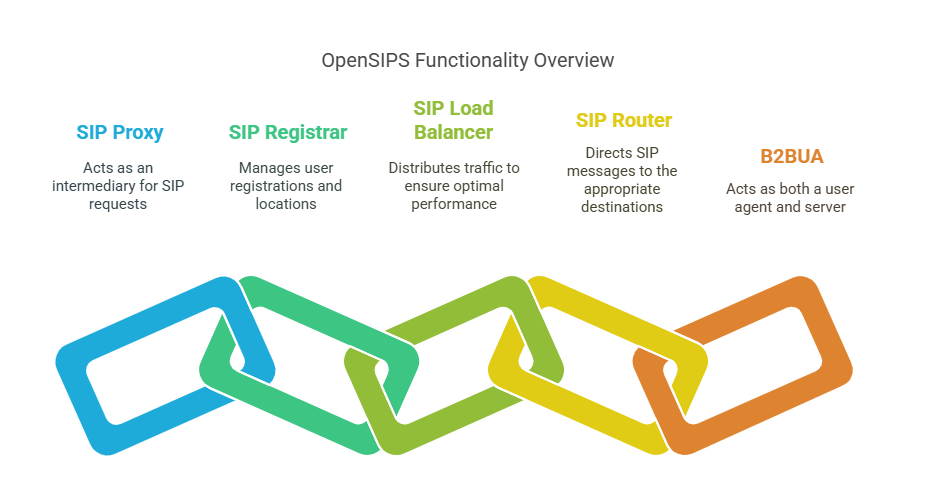Quick Summary
In the blog post that follows, we will explore how you can utilize OpenSIPS for load balancing in a SIP environment, including what load balancing means for VoIP and the need for it in our applications so that our SIP servers will not overload, to maintain call quality, and to maintain high availability. We will also discuss the types of SIP load balancing (e.g. round robin, least-loaded, hash-based), an explanation of how the OpenSIPS modules dispatcher and load_balancer work, the basic steps to configuring the OpenSIPS load balancer, some real-world examples of load balancing, monitoring tools, and best practices in our pursuits to maintain secure and optimize performance. OpenSIPS proves to be a very powerful and flexible way to implement scalable and robust SIP infrastructures.
Content
- What is Load Balancing in SIP Networks?
- Why SIP Networks Need Load Balancing
- Types of Load Balancing in SIP
- Introduction to OpenSIPS
- OpenSIPS as a Load Balancer
- Load Balancing Methods in OpenSIPS
- Setting Up OpenSIPS for Load Balancing
- Real-World Use Cases
- Monitoring and Performance Optimization
- Best Practices and Security
- Conclusion
Introduction
Today’s world of communication used to be one with a predominant focus on Session Initiation Protocol (SIP) networks, forming the foundation of real-time voice, video, mixed messaging, and multimedia sessions. As SIP networks grow and scale, SIP infrastructures need to handle large amounts of concurrent connections for SIP signaling and traffic media without degrading service levels as a result of their high traffic load. Load balancing comes into play.
OpenSIPS, an open-source SIP server, is powerful enough to manage large-scale SIP networks, with its high-performance routing capabilities and the many available modules to create and enhance end-user experiences through optimal load balancing features built into OpenSIPS.
In this blog, we will discuss the approach of load balancing around SIP networks, what load balancing addresses, and how OpenSIPS can be set up to function and provide as a means to create an efficient and scalable VoIP infrastructure.
1. What is Load Balancing in SIP Networks?
Load balancing in SIP networks is the distribution of media traffic or SIP signaling across multiple servers or endpoints. A SIP load balancer is a device that acts as a go-between and sends SIP requests (INVITE, REGISTER…) to SIP servers (SIP proxies, PBXs, media servers…) that are defined in its logic.
2. Why do SIP Networks Need Load Balancing?

SIP networks, primarily in VoIP and Unified Communications scenarios, will have uneven traffic levels and unpredictable loads. In these cases, load balancing is necessary to avoid:
- Overloaded servers causing dropped calls and poor audio quality
- A single point of failure which can lead to complete failure of service
- Inefficient and wasteful use of valued resources that costs more
- Scalability issues when adding more users and/or endpoints
Using a load balancer allows for:
- High availability
- Fault tolerance
- Better response times
- Better resource allocation
3. Load Balancing Types in SIP
Load balancing can take on several strategies in the SIP network.

a. Round Robin
Requests are sent to each server in circular fashion. is simple and rarely predictable due to limited load factor.
b. Least-Loaded
Routes traffic to the server that has the least active sessions (or CPU usage). There is a better chance of evenly allocating load usage across servers with least-loaded.
c. Hash based
Routes traffic to the server based on a hash of user attributes (username, IP address…) ensuring the call is routed to the same server consistently with important elements of the session. It achieves session stickiness when users are provisioned to be sticky to individual servers.
d. Weight based
Every server is given a weight representing capacity. When traffic is directed to each server the server will receive the expected value of more capable servers.
4. Introduction to OpenSIPS

OpenSIPS (Open SIP Server) is an open-source SIP proxy/server and is a mature, program that performs well, is flexible, and is scalable. It serves as:
- SIP proxy
- SIP registrar
- SIP load balancer
- SIP router
- B2BUA (Back to Back User Agent)
It has a modular architecture designed for dynamic configuration, and scriptable routing logic, and many modules available for different purposes, including load balancing.
5. OpenSIPS as a Load Balancer

OpenSIPS performs so well as a SIP load balancer because:
- High performance: It can handle thousands of calls per second.
- Flexibility: custom routing rules defined with scripting for OpenSIPS.
- Advanced modules: such as `dispatcher`, `dialog`, `load_balancer`, and `presence`
- Monitoring: real-time statistics of users in the system and integration with tools like Prometheus
OpenSIPS provides both stateful and stateless load balancing options based on whether you want to keep track of calls.
6. Load Balancing Options in OpenSIPS
a. dispatcher Module
The `dispatcher` module performs stateless load balance. It provides traffic distribution according to different algorithms:
- Round robin
- Hash-based
- Call-ID-based
- SIP URI-based
You can define the destinations (gateways, media servers, SBCs) in a `dispatcher.list` file or database table.
b. Load Balancer Module
The `load_balancer` module provides stateful load balancing. It keeps a real-time count of the load being put on each server. Its features include:
- Automatically selecting servers based on load.
- Session stickiness
- Health checking of nodes.
c. Dynamic Routing
You can set-up dynamic routing and scripting to define custom logic based on user agents, IPs, prefixes, and other variables.
7. Configuring OpenSIPS for Load Balancing
This document will cover the basics for installing and configuring OpenSIPS as a load balancer.
Task 1: Installing OpenSIPS
“`bashsudo apt updatesudo apt install opensips
“`
Task 2: Enabling and Configuring the Dispatcher Module
In `opensips.cfg`:
“`cfg
loadmodule "dispatcher.so"
modparam("dispatcher","db_url","mysql://opensips:password@localhost/opensips")
modparam("dispatcher","flags",2)
“`
Add dispatcher list:
“`cfg
route{
if (is_method("INVITE")){
ds_select_dst("1","4");
t_relay();
exit;
}
}
“`
Task 3: Provide Load Balancer Configuration Module (Stateful optional)
Add:
“`cfgloadmodule "load_balancer.so"modparam("load_balancer","db_url","mysql://opensips:password@localhost/opensips")
“`
Insert destinations in the database by using `load_factor`.
Task 4: Start and Monitor
Restart OpenSIPS and use either the `opensipsctl` or the web control panel to monitor.
8. Use Cases in Real Life
a. VoIP Providers
VoIP Providers utilize OpenSIPS to balance and distribute calls to various media servers and SBCs.
b. Call Centres
Call centres can manage a whole host of customer calls dynamically distributed to agents based on availability.
c. SIP Trunk Aggregators
Wholesale SIP trunking providers balance their load across upstream carriers and media gateways.
d. Telecom Carriers
Telecoms can use OpenSIPS to configure redundancy and during traffic peaks across their regions.
9. Monitoring and Performance Tuning
To maintain balance for effective load balancing, monitoring is important.
Tools:
- OpenSIPS Control Panel GUI
- Grafana + Prometheus
- RTPproxy: Use monitoring for media traffic
- SNMP
Metrics:
- Active dialogs (in SIP)
- CPU and memory load
- Load statistics on a per-node basis
- Failover event logs
The key to performance tuning is:
- Efficient SIP routing application scripts
- Effective shared memory usage
- Make the most of asynchronous processing
10. Best Practices and Security
To help ensure consistency and security use the following:
- Utilize TLS (SIP over secure transport)
- Enable failover nodes in the dispatcher lists
- Employ heartbeat/keepalive checks
- Use OpenSIPS `pike` and `ratelimit` modules to avoid SIP flood attacks
- Schedule separate signalling and media planes
- Back up all dispatcher configurations regularly and have a way to audit them
Conclusion
In most large-scale SIP infrastructures, load balancing is a requirement not a luxury. As VoIP traffic grows, businesses should ensure high availability, redundancy and optimal resources while at the same time supporting customers of the modern business world.
OpenSIPS has the distinction of being one of the best, modular, open source SIP proxy projects available if you are looking for a reliable tool to build SIP load balancing into your application. It supports advanced routing logic and if you work in VoIP or telecom, whether a provider, enterprise, or UCaaS vendor, you can build a scalable, fault tolerant SIP network on an OpenSIPS framework.
At Sheerbit, we love to build scalable communication systems. Our team of VoIP experts can provide you with an end to end VoIP solution. We can help develop your SIP architecture, develop your original OpenSIPS or maintain it, develop ongoing security hardening, implementation of custom features, as well as real-time analytics and monitoring.
We want to be your top choice for advice and consulting whether you are a VoIP startup, a used and established telecom provider, or an enterprise looking to scale your communication infrastructure. We help you build scalable, secure and cost effective SIP networks. Our capabilities of OpenSIPS design allows us to design, maintain and deploy effective load balancing, meaning maximum uptime and uptime based on your desired traffic flow, plus, as much reduced latency across the designated VoIP network.
We provide:
✅ Custom OpenSIPS configuration & module development
✅ Custom load balancing setup and performance optimisation
✅ Highly redundant VoIP Infrastructure
✅ SIP Routing, needs of DNA traversal, fail over, clustering
✅ Real-time monitoring & analytics
✅ Useable between FreeSWITCH, AsterisK, RTPproxy, Kamailio, among others.
While we handle your VoIP backend we can be put in charge of your communication services!




